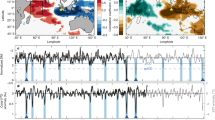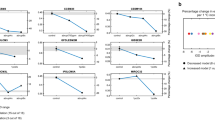Abstract
The Indian Ocean Dipole1,2 (IOD)—an oscillatory mode of coupled ocean–atmosphere variability—causes climatic extremes and socio-economic hardship throughout the tropical Indian Ocean region1,2,3,4,5. There is much debate about how the IOD interacts with the El Niño/Southern Oscillation (ENSO) and the Asian monsoon, and recent changes in the historic ENSO–monsoon relationship6 raise the possibility that the properties of the IOD may also be evolving. Improving our understanding of IOD events and their climatic impacts thus requires the development of records defining IOD activity in different climatic settings, including prehistoric times when ENSO and the Asian monsoon behaved differently from the present day. Here we use coral geochemical records from the equatorial eastern Indian Ocean to reconstruct surface-ocean cooling and drought during individual IOD events over the past ∼6,500 years. We find that IOD events during the middle Holocene were characterized by a longer duration of strong surface ocean cooling, together with droughts that peaked later than those expected by El Niño forcing alone. Climate model simulations suggest that this enhanced cooling and drying was the result of strong cross-equatorial winds driven by the strengthened Asian monsoon of the middle Holocene. These IOD–monsoon connections imply that the socioeconomic impacts of projected future changes in Asian monsoon strength may extend throughout Australasia.
This is a preview of subscription content, access via your institution
Access options
Subscribe to this journal
Receive 51 print issues and online access
$199.00 per year
only $3.90 per issue
Buy this article
- Purchase on Springer Link
- Instant access to full article PDF
Prices may be subject to local taxes which are calculated during checkout




Similar content being viewed by others
References
Webster, P. J., Moore, M. D., Loschnigg, J. P. & Leben, R. R. Coupled ocean–atmosphere dynamics in the Indian Ocean during 1997–98. Nature 401, 356–360 (1999)
Saji, H. H., Goswami, B. N., Vinayachandran, P. H. & Yamagata, T. A dipole mode in the tropical Indian Ocean. Nature 401, 360–363 (1999)
Ashok, K., Guan, Z. & Yamagata, T. Influence of the Indian Ocean Dipole on the Australian winter rainfall. Geophys. Res. Lett. 30 1821 doi: 10.1029/2003GL017926 (2003)
Abram, N. J., Gagan, M. K., McCulloch, M. T., Chappell, J. & Hantoro, W. S. Coral reef death during the 1997 Indian Ocean Dipole linked to Indonesian wildfires. Science 301, 952–955 (2003)
Birkett, C., Murtugudde, R. & Allan, T. Indian Ocean climate event brings floods to East Africa's lakes and the Sudd Marsh. Geophys. Res. Lett. 26, 1031–1034 (1999)
Kumar, K. K., Rajagopalan, B. & Cane, M. A. On the weakening relationship between the Indian Monsoon and ENSO. Science 284, 2156–2159 (1999)
Behera, S. K. et al. A CGCM study on the interactions between IOD and ENSO. J. Clim. 19, 1688–1705 (2006)
Fischer, A. S., Terray, P., Guilyardi, E., Gualdi, S. & Delecluse, P. Two independent triggers for the Indian Ocean Dipole/Zonal Mode in a coupled GCM. J. Clim. 18, 3428–3449 (2005)
Charles, C. D., Cobb, K. M., Moore, M. D. & Fairbanks, R. G. Monsoon-tropical ocean interaction in a network of coral records spanning the 20th century. Mar. Geol. 201, 207–222 (2003)
Beck, J. W. et al. Sea-surface temperatures from coral skeletal strontium/calcium ratios. Science 257, 644–647 (1992)
Gagan, M. K. et al. Temperature and surface-ocean water balance of the mid-Holocene tropical western Pacific. Science 279, 1014–1018 (1998)
Briggs, R. W. et al. Deformation and slip along the Sunda Megathrust in the great 2005 Nias-Simeulue earthquake. Science 311, 1897–1901 (2006)
Reynolds, R. W. & Smith, T. M. Improved global sea surface temperature analyses using optimum interpolation. J. Clim. 7, 929–948 (1994)
Charles, C. D., Hunter, D. E. & Fairbanks, R. G. Interaction between the ENSO and the Asian monsoon in a coral record of tropical climate. Science 277, 925–928 (1997)
Eaton, P. & Radojevic, M. Forest Fires and Regional Haze in Southeast Asia (Nova Science Publishers, Huntington, New York, 2001)
Sontakke, N. A., Pant, G. B. & Singh, N. Construction of all-India summer monsoon rainfall series for the period 1844–1991. J. Clim. 6, 1807–1811 (1993)
Yuan, D. et al. Timing, duration, and transitions of the Last Interglacial Asian monsoon. Science 304, 575–578 (2004)
Moy, C. M., Seltzer, G. O., Rodbell, D. T. & Anderson, D. M. Variability of El Nino/Southern Oscillation activity at millennial timescales during the Holocene epoch. Nature 420, 162–165 (2002)
Gagan, M. K., Hendy, E. J., Haberle, S. G. & Hantoro, W. S. Post-glacial evolution of the Indo-Pacific Warm Pool and El Nino-Southern Oscillation. Quat. Int. 118–119, 127–143 (2004)
Koutavas, A., Lynch-Stieglitz, J., Marchitto, T. M. & Sachs, J. P. El Nino-like pattern in Ice Age tropical Pacific sea surface temperature. Science 297, 226–230 (2002)
Ashrit, R. G., Kumar, K. R. & Kumar, K. K. ENSO-monsoon relationships in a greenhouse warming scenario. Geophys. Res. Lett. 28, 1727–1730 (2001)
Hu, Z.-Z., Latif, M., Roeckner, E. & Bengtsson, L. Intensified Asian summer monsoon and its variability in a coupled model forced by increasing greenhouse gas concentrations. Geophys. Res. Lett. 27, 2681–2684 (2000)
Zickfeld, K., Knopf, B., Petoukhov, V. & Schellnhuber, H. J. Is the Indian summer monsoon stable against global change?. Geophys. Res. Lett. 32 L15707 doi: 10.1029/2005GL022771 (2005)
Liu, Z., Brady, E. & Lynch-Stieglitz, J. Global ocean response to orbital forcing in the Holocene. Paleoceanography 18 1041 doi: 10.1029/2002PA000819 (2003)
Liu, Z., Harrison, S. P., Kutzbach, J. & Otto-Bliesner, B. Global monsoons in the mid-Holocene and oceanic feedback. Clim. Dyn. 22, 157–182 (2004)
Dai, A. & Wigley, T. M. L. Global patterns of ENSO-induced precipitation. Geophys. Res. Lett. 27, 1283–1286 (2000)
Kumar, K. K., Rajagopalan, B., Hoerling, M., Bates, G. & Cane, M. Unraveling the mystery of Indian monsoon failure during El Nino events. Science 314, 115–119 (2006)
Anderson, D. M., Overpeck, J. T. & Gupta, A. K. Increase in the Asian southwest monsoon during the past four centuries. Science 297, 596–599 (2002)
Xie, P. & Arkin, P. A. Analyses of global monthly precipitation using gauge observations, satellite estimates, and numerical model predictions. J. Clim. 9, 840–858 (1996)
Acknowledgements
We thank D. Prayudi, I. Suprianto, K. Glenn, T. Watanabe, H. Scott-Gagan, K. Sieh and the Indonesian Institute of Sciences (LIPI) for assistance with fieldwork, which was carried out under research permits issued by LIPI. We thank H. Scott-Gagan, J. Cali, G. Mortimer, A. Alimanovic and D. Kelleher for laboratory assistance, and R. Gallimore and P. Behling for the model simulations and model output processing. This study was supported by an Australian Postgraduate Award and RSES Jaeger Scholarship to N.J.A., and an Australian Research Council Discovery grant to M.K.G. and W.S.H.
Author Contributions N.J.A. was responsible for coral geochemical analysis and interpretation of the records. M.K.G. was Chief Investigator and the Australian Institutional Counterpart for the ARC project. Z.L. provided climate model simulations and advice on ocean–atmosphere interactions. W.S.H. was Partner Investigator and the Indonesian Institutional Counterpart for the ARC project. M.T.M. supported the TIMS Sr/Ca analyses. B.W.S. provided extensive logistical support for fieldwork. N.J.A and M.K.G. wrote the paper, with comments provided by all other authors.
Author information
Authors and Affiliations
Corresponding authors
Ethics declarations
Competing interests
Reprints and permissions information is available at www.nature.com/reprints. The authors declare no competing financial interests.
Supplementary information
Supplementary Information
This file contains Supplementary Methods, Supplementary Table S1 with details of coral samples used in this study, Supplementary Figures S1-S4 and Supplementary Plates S1-S7. Supplementary Figure S1 shows a comparison of SST and rainfall products for the Mentawai Islands. Supplementary Figure shows Coral Sr/Ca-SST calibration for the Mentawai Islands Supplementary Figure S3 shows Coral Sr/Ca-SST and Δ δ18O records of individual IOD events. Supplementary Figure S4 shows a comparison of the average annual cycle of coral Sr/Ca-SST and Δ δ18O during the middle Holocene and the late Holocene. Supplementary Plate S1 shows X-radiograph image of coral TM01-A-10. Supplementary Plate S2 shows X-radiograph image of coral TN99-A-4. Supplementary Plate S3 shows X-radiograph image of coral PG01-A-2, 2b. Supplementary Plate S4 shows X-radiograph image of coral P01-B-1. Supplementary Plate S5 shows X-radiograph image of coral TF99-A-5. Supplementary Plate S6 shows X-radiograph image of coral LB99-A-7. Supplementary Plate S7 shows X-radiograph image of coral TN99-A-1a (PDF 34990 kb)
Supplementary Table
This file contains Supplementary Table S2 which shows the coral Sr/Ca and δ18O data for individual and composite IOD events (XLS 100 kb)
Rights and permissions
About this article
Cite this article
Abram, N., Gagan, M., Liu, Z. et al. Seasonal characteristics of the Indian Ocean Dipole during the Holocene epoch. Nature 445, 299–302 (2007). https://doi.org/10.1038/nature05477
Received:
Accepted:
Issue Date:
DOI: https://doi.org/10.1038/nature05477
This article is cited by
-
Zonal control on Holocene precipitation in northwestern Madagascar based on a stalagmite from Anjohibe
Scientific Reports (2024)
-
Revisiting the Seasonal Evolution of the Indian Ocean Dipole from the Perspective of Process-Based Decomposition
Journal of Ocean University of China (2023)
-
Coral Sr/Ca records provide realistic representation of eastern Indian Ocean cooling during extreme positive Indian Ocean Dipole events
Scientific Reports (2022)
-
Stormier mid-Holocene southwest Indian Ocean due to poleward trending tropical cyclones
Nature Geoscience (2022)
-
Climate change in the Indo-Pacific basin from mid- to late Holocene
Climate Dynamics (2022)
Comments
By submitting a comment you agree to abide by our Terms and Community Guidelines. If you find something abusive or that does not comply with our terms or guidelines please flag it as inappropriate.



